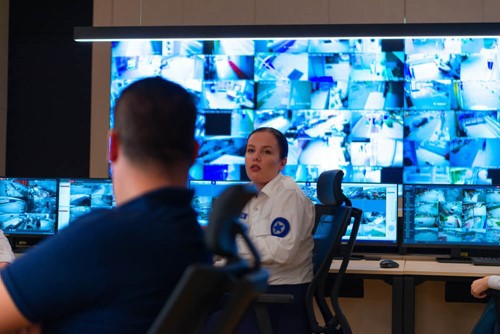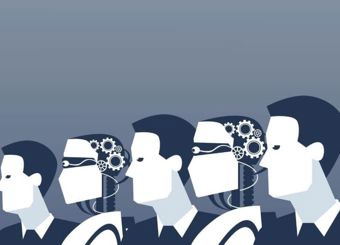The top 6 tech trends in 2020 you need to know about
Digital transformation continues to make meaningful changes to our society, everyday life and workplaces. It’s all in the aid of making things simpler, more efficient, easier and more accessible.
In 2020, there’s a glut of emerging technologies that’s got the capability to achieve all the above and we’ll explore six of them in this blog post.
#1 – Hyperautomation

Hyperautomation has been touted as the next evolution of robotic process automation (RPA) a topic we’ve blogged extensively about. It uses multiple branches of machine learning, complex software and specially designed automation platforms to deliver outcomes.
In addition to the tools described, Hyperautomation also covers the process its automating itself. It includes these categories:
- Discover
- Analyze
- Design
- Automate
- Measure
- Monitor
- Reassess
The primary goal for Hyperautomation is to understand the range of tasks that can be automated, what’s required to automate the jobs, and how the constituent parts of the task work with one another to achieve the desired outcome.
Hyperautomation is something Pete Kinder, Chief Technology Officer at Medius, has explored. He says: “Medius Spend Management, is designed to make working easier for procurement and finance professionals. It leverages elements of RPA to automate everything from contract management to managing suppliers and of course, buying.
“Hyperautomation has the scope to automate even more of procurement, freeing up valuable time for procurement professionals to focus on other business-critical tasks.”
#2 – Human augmentation

It’s the stuff of science fiction, but human augmentation is set to have a big year in 2020. For the uninitiated, human enhancement is a discipline designed to boost mankind’s abilities through medicine or technology – and it’s the tech we’re most interested in.
Improvements to human capabilities come in two flavors. These are:
Physical augmentations – involves enhancing recipients’ physical capabilities by installing or hosting a technological element on their bodies, such as a wearable device
Cognitive augmentations – also known as Intelligence Amplification (IA) are constituent technologies designed to complement and enhance human intelligence. Examples include calculators, computers and mobile phones.
While we aren’t predicting a sudden shift to augmented human beings, with a raft of cybernetic implants and enhanced mental abilities, we believe that next year, there’ll be a significant announcement related to human augmentation.
Elon Musk tested Neuralink, an integrated brain-machine interface, on a chimpanzee, allowing it to control a Windows 10 machine with just its mind. Subject to FDA approval, Musk and his team will test the same technology on a quadriplegic man in 2020.
https://www.youtube.com/watch?v=lA77zsJ31nA
In an example of physical wearables, BioTeq, a human implants firm, is distributing tiny implants that are surgically inserted into the space between your thumb and index finger. These implants can contain everything from RFID readers to open doors to workplaces, activate printers and start the engine of your car. The company says it’s receiving more and more interest from security-conscious employers all over the world.
https://www.youtube.com/watch?v=LP1LYz-erh0
Pete Kinder is cautiously optimistic about wearable technology. He says: “I’m genuinely interested in the applications of human augmentation and wearable technology. They’ve got tremendous potential to help humanity take the next evolutionary step
“The trick is to strike a balance between making technological advancements and mitigating ethical and privacy concerns.”
#3 – Edge Computing

2020 is set to be an important year for edge computing; a network setup that focuses on decentralizing data processing and processing power. Instead of things being handled in a far-away data center, data is interpreted by the device itself or a local computer or device – eliminating latency.
https://www.youtube.com/watch?v=cEOUeItHDdo
What this means in real terms is that it allows data processing to happen in real-time without any sort of lag or delay. This is imperative for technologies that need instantaneous decisions to be made such as driverless cars, online gaming and many other practical applications.
For businesses, edge computing can make data processing more efficient. Instead of it being done far away in a centralized location, large volumes can be handles closer to the source, reducing bandwidth usage. This is especially important for organizations that are conscious of consuming excessive bandwidth in their day-to-day operations.
While the cloud remains one of the most secure options for hosting data, some organizations such as those operating in the defense industry prefer something slightly more private. While the private cloud has been proven to be a popular and successful solution, it remains costly and anxieties remain about it still being cloud-based. Edge computing provides an eloquent solution, where sensitive data never has to be uploaded to the cloud; maintaining an on-premise solution.
Pete Kinder thinks that 5G will have a significant role to play in edge computing. “5G is the latest wireless internet connection being rolled out in small areas of the UK right now. It offers much-reduced latency and extremely fast download and upload speeds.
He adds: “It all depends on how quickly this comes to market and how secure it is – as to whether it will see mainstream adoption or not. 2020 will be an important year for this technology as its global rollout continues.”
#4 – AI Security

Cybersecurity will remain one of the most important issues in 2020. In October alone, according to IT governance, 421 million records were breached with 111 major incidents reported. Nine of these 111, were UK-based incidents, and costs around $600 billion to the global economy.
With GDPR on the lips of most organizations operating in and around Europe, and with the hefty fines associated with data breaches, security is a crucial issue for a successful business.
AI Security will help improve existing cybersecurity processes by using AI to bolster organizations existing cybersecurity measures. For instance, hyperautomation could be used to orchestrate sophisticated cyberattacks, whereby malicious parties automate measures to launch a sustained attack against a target.
Expect more to be made of AI Security in 2020, where a watchful eye stands guard on your systems. Organizations such as Darktrace offer enterprise security monitoring systems that use AI to understand how your organization works, how your users operate and quickly learn, identify and shore up weak points on your system – without you having to do anything.
#5 – Autonomous things

Autonomous things are set to have their breakthrough year in 2020. With edge computing set to help things like driverless vehicles make split-second decisions, without the need for expansive onboard computing systems, autonomous things will explode in their application over the next ten years or so.
Apart from driverless cars, autonomous things cover a wide range of other devices such as:
Logistics robots – the Amazon Scout is the eCommerce giant’s solution to its myriad delivery challenges. It’s an autonomous drone that delivers goods to its customers’ door. It’s still experimental technology and is only out making deliveries in select locations during the day. Away from deliveries, self-driving forklifts can move goods around a warehouse, as well as aerial drones to map and monitor large areas.
Home robotics – in the not so distant future, assistant robots will be undertaking tasks in our homes to ease the burden of everyday life. For instance, this robot Aido helps its owners with day-to-day tasks such as cleaning, tutoring children and home security. While it’s still a concept right now, the technology isn’t far off from being implemented.
Further in the future are domestic robots designed to fulfill the roles of care workers for older people. They’ll be able to undertake simple domestic tasks to ease the burden on the care industry.
For the procurement industry, autonomous things could make a significant contribution to the overall efficiency of the supply chain. Kinder had this to say: “Automating warehouse management with technology such as driverless forklifts and autonomous drones, will speed up and streamline warehouse operations all over the world.
“While 2020 won’t be the year everyone starts using these technologies in the supply chain, expect more organizations to talk up the benefits of using autonomous things to achieve efficiency and productivity gains in the warehouse and logistics operations.”
#6 – Transparency and traceability

According to research by Gallup, two-thirds of adults say corruption is widespread in business all over the world – illustrating that trust in big corporations is a real issue.
Amongst the most important issues for businesses across the UK and the world centers around personal data, and crucially, how this information is used. The furore around Cambridge Analytica, and the way they used personal data made available through a Facebook app, caused outrage all over the world.
Campaigners have lobbied governments to introduce and tighten existing data protection measures. In response, the EU introduced GDPR which all member states signed up to and must adhere to, in order to remain part of the trading bloc. Any company that operates in the EU, and exchanges data with EU citizens must be compliant with GDPR or face hefty fines.
Environmental issues are increasingly coming into focus following activism from people like Greta Thunberg and David Attenborough. Organizations are under pressure to reduce their carbon footprint, plastic consumption and illustrate their green credentials.
In 2020, expect this trend to continue, with more businesses seeking to demonstrate their green credentials, to win consumer’s hearts and minds. A more open and transparent strategy around your green capabilities could be inspired as research from Nielsen shows that 66% of consumers would rather pay more for sustainable goods, with that figure rising to 73% if you’re talking about Millennials.
The bottom line is that in 2020, large organizations must do more to repair trust between themselves and consumers – and it should start with procurement. Daniel Ball, Business Development Director at Medius explains:
“Procurement has an important role to play in shaping the way your organization is perceived. First, ensure that you’re selecting suppliers in your supply chain that are sustainable, but also use sustainable suppliers themselves.
“In addition, you’ll want to ensure you can trace anything you purchase to the point where the raw materials are harvested. This is so you can monitor for issues like modern slavery or identify if a supplier’s failure to adhere to their green credentials.”
Ball adds: “Next, communicate these things to your marketing and PR departments so your organization can design a strategy to communicate your commitment to sustainability. Only then will consumers regain confidence in your organization.”
What do you think will be a big tech trend in 2020?
In a sea of technological advances, we’ve only picked out six to talk about. Is there anything you think we’ve missed? Is there anything you think that in 2020 and beyond is set to be a major issue? Let us know on our LinkedIn or Twitter accounts.
If you’re interested in reading more of this type of content, sign up to our mailing list here.





